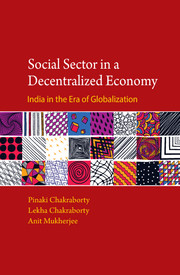Book contents
- Frontmatter
- Contents
- List of Tables, Figures, Boxes and Appendices
- List of Abbreviations
- Preface
- 1 Unpacking Decentralization
- 2 Decentralization in Service Delivery: Empirical Evidences
- 3 Decentralization in India: History, Laws and Politics
- 4 Local-level Fiscal Decentralization: State Finance Commissions and Devolution
- 5 Decentralization of Education
- 6 Decentralization in Health Service Delivery
- 7 Measuring Benefit Incidence: Health and Education
- 8 Effectiveness of Decentralization on Service Delivery: Accountability and Efficiency
- 9 What We Have Learnt and the Way Ahead
- Bibliography
- Index
7 - Measuring Benefit Incidence: Health and Education
Published online by Cambridge University Press: 26 September 2017
- Frontmatter
- Contents
- List of Tables, Figures, Boxes and Appendices
- List of Abbreviations
- Preface
- 1 Unpacking Decentralization
- 2 Decentralization in Service Delivery: Empirical Evidences
- 3 Decentralization in India: History, Laws and Politics
- 4 Local-level Fiscal Decentralization: State Finance Commissions and Devolution
- 5 Decentralization of Education
- 6 Decentralization in Health Service Delivery
- 7 Measuring Benefit Incidence: Health and Education
- 8 Effectiveness of Decentralization on Service Delivery: Accountability and Efficiency
- 9 What We Have Learnt and the Way Ahead
- Bibliography
- Index
Summary
Theoretically, there are two approaches to analyze the distributional impacts of public expenditure in social sector – in particular, education and health sector, benefit incidence studies and behavioural approaches. The behavioural approach is based on the notion that a rationed publicly provided good or service should be evaluated at the individual's own valuation of the good. This is what Demery (2000) called as a ‘virtual price’. Such prices will vary from one individual to another. This approach emphasizes the measurement of individual preferences for the publicly provided goods. The methodological complications in the valuation of revealed preferences based on the microeconomic theory and the paucity of unit record data related to the knowledge of the underlying demand functions of individuals or households led to less practicability of the behavioural approaches in estimating the distributional impact of public expenditure.
The second approach, Benefit Incidence Analysis (BIA), is a relatively simple and practical method for estimating distributional impact of public expenditure across different demographic and socioeconomic groups. The genesis of this approach lies in the path-breaking work by Meerman (1979) on Malaysia and Selowsky (1979) on Colombia. BIA involves allocating unit cost according to individual utilization rates of public services. BIA can identify how well public services are targeted to certain groups in the population, across gender, income quintiles and geographical units. The studies on BIA revealed that a disproportionate share of the health budget benefits the elite in urban areas, or that the major part of education budget benefits schooling of boys rather than girls, which has important policy implications.
Public expenditure: Benefit Incidence Analysis (BIA) theory and methodology
Following Demery (2000), there are four basic steps towards calculating benefit incidence.
Estimating unit cost
The unit cost of a publicly provided good is estimated by dividing the total expenditure on that particular publicly provided good by the total number of users of that good. This is synonymous to the notion of per capita expenditure, but the denominator is confined to the subset of population who are the users of the public good.
- Type
- Chapter
- Information
- Social Sector in a Decentralized EconomyIndia in the Era of Globalization, pp. 143 - 168Publisher: Cambridge University PressPrint publication year: 2016
- Creative Commons
- This content is Open Access and distributed under the terms of the Creative Commons Attribution licence CC-BY-NC-ND 3.0 IGO https://creativecommons.org/cclicenses/



